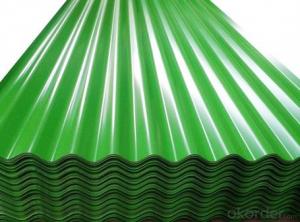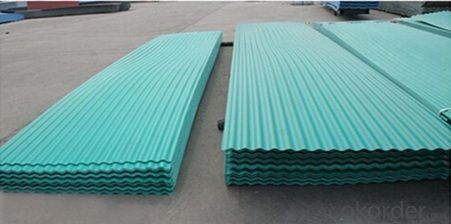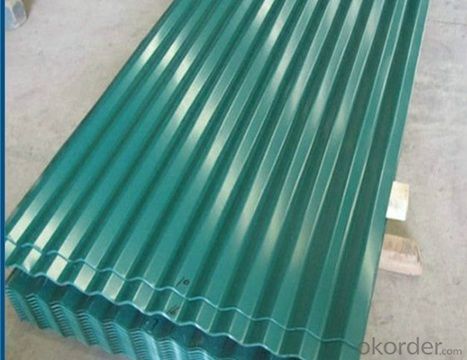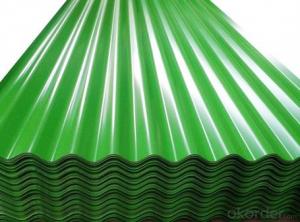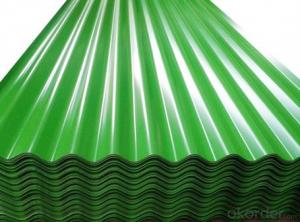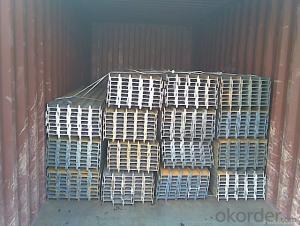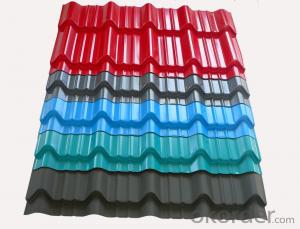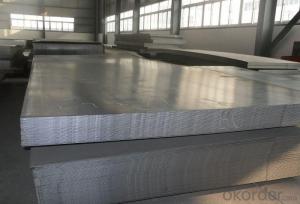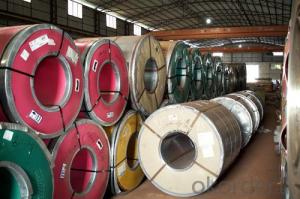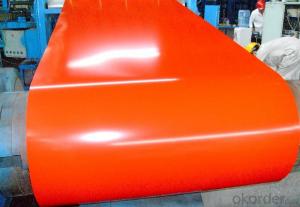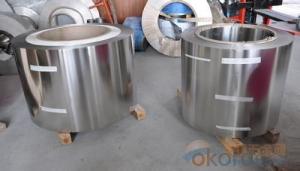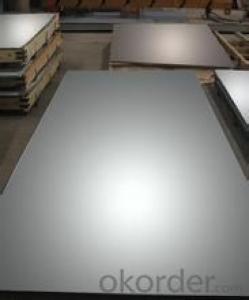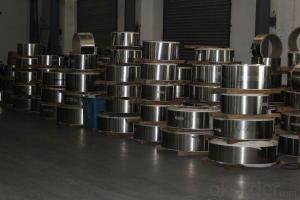Premium Colored Corrugated Roofing Metal Sheet
- Loading Port:
- Tianjin
- Payment Terms:
- TT OR LC
- Min Order Qty:
- 50 m.t.
- Supply Capability:
- 2000 m.t./month
OKorder Service Pledge
OKorder Financial Service
You Might Also Like
Specification
Product Brief Introduction
Premium Colored Corrugated Roofing Metal Sheet
--- Corrosion resistance: Pre-coated steel offers excellent corrosion resistance achived through continuous hot DIP galvanization and corrosion resistant primer/polyester coating. Protection is achieved when zinc and steel are together in the presence of moisture; The zinc protects the steel by galvanic action
Product Features
. Traditional aesthetics outlook
. Suitable for new house or renovation.
. Less joints, watertight
. Long life service
. Tedun also provide relative ridge cap, fasteners and other accessories
Product Specification
Standard:ASTM, GB,JIS,JIS G3302 ASTM 755 EN10169
Grade: DX51D CGCC CS
Thickness: 0.13mm~3.0mm,
Width: 1250,600-1250mm
Coil weight:3-12 MT
Coil ID:508/610mm
Chemical composition:
C | Si | Mn | Cr | Ni | P | S |
0.150 | 0.476 | 11.231 | 12.50 | 0.900 | 0.039 | 0.010
|
FAQ
How long will we receive the goods ?
45days after receiving workable L/C
2. how do you control the quality ?
we have our own quality control department ,we will arrange QC person to see the production line ,when goods finish ,before shipment ,our QC person will check the quality as per our test report request ,if the goods is ok ,then we issue the test report ,and we allow the goods shipping ,otherwise will not allow ship the goods.

- Q: Are steel strips commonly used in the manufacturing of furniture?
- No, steel strips are not commonly used in the manufacturing of furniture.
- Q: How are steel strips used in the production of hand tools?
- Due to their durability and versatility, steel strips find wide application in the manufacturing of hand tools. These strips are typically made from high-quality steel alloys, which offer exceptional strength and wear resistance. In the production process, steel strips are initially cut into desired dimensions and then undergo various forming operations such as bending, stamping, or rolling. This allows the strips to take on the specific shapes required for hand tool components, including blades, handles, or shafts. The flexibility of steel strips enables the production of a diverse range of tool designs to meet varied application needs. Once the components are shaped, they undergo further processing through heat treatment, which enhances their hardness and toughness. This treatment ensures that the hand tools can endure significant force, impact, and wear during use, making them highly durable and long-lasting. Steel strips are also utilized in the production of hand tool accessories, such as springs, clips, or fasteners. These components play crucial roles in enhancing the functionality and usability of the tools. For example, springs made from steel strips provide the necessary tension or pressure required for certain hand tools, like pliers or clamps. Furthermore, steel strips can be coated or plated with protective finishes, such as chrome or nickel, to enhance their corrosion resistance and improve the overall aesthetics of the hand tools. This added layer of protection ensures that the tools remain in good condition even in challenging working environments. In summary, steel strips are indispensable in the production of hand tools as they provide the necessary strength, durability, and versatility for various applications. From blades to handles, these strips enable the creation of high-quality tools that can withstand rigorous use and deliver exceptional performance.
- Q: Can steel strips be used in the transportation industry?
- Steel strips have a wide range of applications in the transportation industry. Their versatility and durability make them suitable for various purposes. In the manufacturing process, they can be utilized to create different components, including brackets, supports, and reinforcements for vehicles such as cars, trucks, trains, and ships. Due to their high strength and resistance to impact and deformation, steel strips are commonly used in the construction of chassis, frames, and body panels. They also play a crucial role in the production of springs, suspension systems, and exhaust systems, which are essential for ensuring the smooth and safe operation of vehicles. Overall, the transport industry relies heavily on steel strips, appreciating their reliability, strength, and versatility.
- Q: How are steel strips protected against corrosion?
- Steel strips are protected against corrosion through a variety of methods. The most common method is by applying a protective coating on the surface of the steel. This can be done through processes such as galvanizing, where a layer of zinc is applied to the steel. Zinc acts as a sacrificial anode, meaning that it oxidizes before the steel does, thereby protecting it from corrosion. Another method is by applying a layer of paint or enamel on the steel surface. This creates a barrier between the steel and the surrounding environment, preventing moisture and other corrosive elements from coming into contact with the steel. Additionally, steel strips can also be protected through the use of corrosion inhibitors. These are chemicals that are added to the surface of the steel, forming a protective layer that inhibits corrosion. Overall, the goal is to create a barrier or sacrificial layer that prevents the steel from being exposed to corrosive elements, thus extending its lifespan and maintaining its structural integrity.
- Q: How are steel strips tested for internal defects?
- Steel strips are typically tested for internal defects using non-destructive testing methods such as ultrasonic testing or magnetic particle inspection. These techniques involve the use of specialized equipment to detect and analyze any internal flaws or irregularities in the steel strips without causing any damage to the material.
- Q: What are the different sizes and dimensions of steel strips?
- The sizes and dimensions of steel strips can vary depending on the specific application and industry requirements. However, common sizes range from thin strips measuring around 0.1mm to thicker strips up to 20mm in thickness. The width of steel strips can range anywhere from a few millimeters to several hundred millimeters, while the length can vary from a few meters to coils of several kilometers. It's important to note that these dimensions can be further customized based on the needs of the customer and the intended use of the steel strips.
- Q: Can steel strips be used in low-temperature environments?
- Yes, steel strips can be used in low-temperature environments. Steel is known for its strength and durability, even in extreme conditions. It has good resistance to low temperatures and remains mechanically stable, making it suitable for various applications such as construction, manufacturing, and transportation in cold climates. However, it is important to consider the specific grade and composition of the steel to ensure it is suitable for the desired low-temperature environment.
- Q: How are steel strips processed for roll forming?
- In order to achieve the desired shape and dimensions, steel strips undergo a series of steps for roll forming. The process begins by uncoiling a large coil of steel strip, which is then fed into a roll forming machine. The steel strip is gradually shaped into the desired profile as it passes through a series of rollers. These rollers are meticulously designed to create specific bends, curves, and angles in the strip. The number and arrangement of the rollers can vary depending on the complexity of the desired shape. To ensure accurate and consistent shaping, the steel strip is carefully guided and supported as it goes through the rollers. Guide rolls, side rolls, and idler rolls are employed to maintain the strip's position and prevent any wrinkling or twisting during the process. To further enhance the shaping process, some roll forming machines may incorporate additional techniques such as pre-notching or pre-punching. These techniques involve making small cuts or holes in the strip prior to entering the rollers, facilitating easier bending and forming. Once the steel strip has been fully shaped, it is then cut to the desired length. This can be done either during the roll forming process itself or as a separate step afterwards. Various cutting methods, including shearing, sawing, or punching, can be utilized depending on the specific requirements of the final product. Following the cutting stage, the formed steel strips may undergo additional processes such as hole punching, embossing, or adding surface finishes. These processes serve to enhance the functionality or aesthetic appeal of the final product. Overall, the roll forming process for steel strips involves precise shaping, meticulous support, and accurate cutting to produce a wide range of profiles and shapes. This versatile manufacturing technique is extensively utilized in industries such as construction, automotive, and appliances to manufacture components and structures that possess high strength and durability.
- Q: How are steel strips used in the agricultural machinery sector?
- Steel strips are used in the agricultural machinery sector for various purposes such as manufacturing components like blades, cutting edges, and plowshares, providing structural strength to equipment like tractors and harvesters, and reinforcing the framework of machinery to ensure durability and reliability.
- Q: How do steel strips perform in terms of electromagnetic shielding?
- Steel strips are highly effective in terms of electromagnetic shielding. Due to their conductive properties, they can efficiently block and divert electromagnetic waves, providing excellent protection against interference and reducing electromagnetic radiation.
Send your message to us
Premium Colored Corrugated Roofing Metal Sheet
- Loading Port:
- Tianjin
- Payment Terms:
- TT OR LC
- Min Order Qty:
- 50 m.t.
- Supply Capability:
- 2000 m.t./month
OKorder Service Pledge
OKorder Financial Service
Similar products
Hot products
Hot Searches
Related keywords
